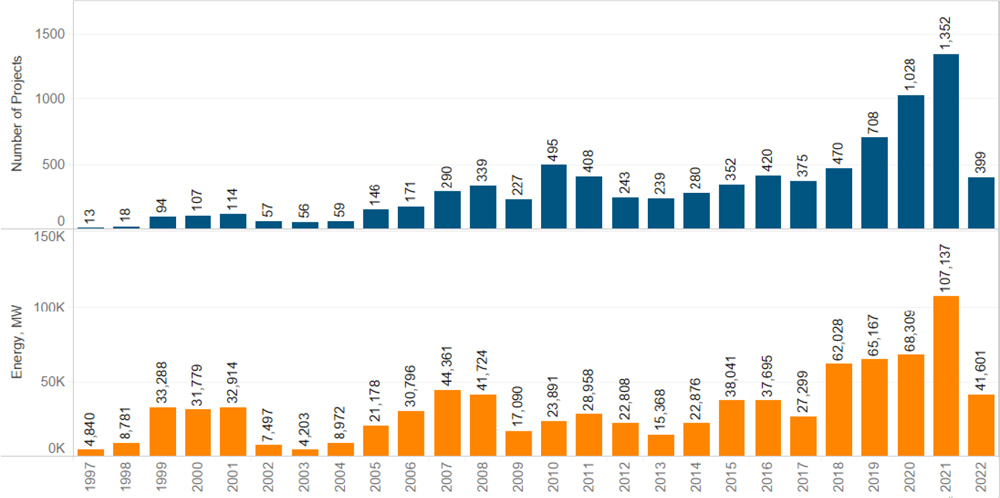PJM filed its long-awaited plan for untangling its interconnection queues Tuesday, proposing to switch from a serial “first-come, first-served” approach to a “first-ready, first-served” cycle (ER22-2110).
The result of 18 months of stakeholder discussions, the changes won sector-weighted support of 87% at the Markets and Reliability Committee and 90% at the Members Committee in April, well above the necessary two-thirds threshold for approval. (See PJM Stakeholders Endorse New Interconnection Process.)
“PJM believes, as do the vast majority of PJM stakeholders, that these reforms will vastly improve today’s interconnection process in the PJM region,” the RTO said.
The new rules are laid out in three new parts of the Open Access Transmission Tariff and changes to four others. Separately, PJM’s transmission owners are expected to file tariff revisions to incorporate their controversial proposal to fund network upgrades and add them to their rate bases (ER21-2282). (See FERC Establishes Paper Hearing on PJM Rate-base Network Upgrades.)
PJM asked the commission to approve the provisions by Oct. 3 with an effective date of Jan. 3, 2023, for most of the changes and an “indefinite” effective date for the new Part VIII of the tariff, saying “it is unknown when the preconditions for those tariff sections will be satisfied.” It proposed a 30-day comment period rather than the standard 21-day period.
But the RTO also acknowledged that FERC is considering its own changes to the interconnection process (RM21-17) and that “that further reforms may be required in the future.” (See FERC Goes Back to the Drawing Board on Tx Planning, Cost Allocation.)
The new rules would transition from a serial queue process to a clustered cycle process for both studies and cost allocation. The proposal includes a transition period that PJM said would allow “mature” projects to complete the existing process.
PJM said the proposal is similar to the rules used by SPP, MISO and PacifiCorp. It would add multiple decision points at which those seeking interconnection will be required to make readiness deposits and meet other threshold requirements to continue, “thus permitting projects that are ready to progress to do so while incentivizing projects that are not ready to proceed to exit,” the RTO said.
It also said more timely processing of interconnection requests “will enable PJM to support federal and state public policy (including various renewable and clean energy initiatives).”
The process includes a “fast lane” for projects with minimal network impact or cost responsibility.
The existing interconnection process accepts new service requests during two six-month queue windows annually (April 1 to Sept. 30, and Oct. 1 to March 31 of the following year). Interconnection customers are required to provide evidence of site control only for their generator sites and only once, at the beginning of the process.
“The time-intensive serial approach of PJM’s current interconnection process, coupled with the exponential increase in new services requests received in each queue window in recent years has resulted in a mounting backlog,” PJM said. It noted that the volume of new service requests increased 25% in 2018 over 2017, with another 50% jump in 2019. By 2021, the requests had almost tripled from 2018.
 Total new services requests by year | PJM
Total new services requests by year | PJM
“The delays arising from sheer volume are exacerbated by the large number of speculative projects that withdraw from the queue because they cannot be completed,” PJM added. “For almost every project that withdraws, PJM must restudy lower-queued projects to ensure the proper upgrades are identified and built to meet planning criteria and maintain reliability, which results in delays in processing those other new service requests. These withdrawals also create significant cost uncertainty for lower-queued projects, which may cause those projects to withdraw, causing a cascade of withdrawals.”
In the past, about one-third of projects withdrew from the queue after the feasibility study, but that has dropped to about 5% currently, leaving “many projects languishing in the queue only to drop out at a rate that totals 80% of the total,” PJM said.
PJM proposed implementing the new rules to new service requests submitted on or after Oct. 1, 2021, the opening of the AH2 queue.
“The new rules also establish system impact studies and cost allocation on a cycle-wide basis, rather than an individual project basis, which are designed to streamline the study process, reduce retool studies, and reduce cost responsibility and cost allocation disputes,” PJM said. “Providing incentives for the early exit of projects that are not ready (financially or otherwise) and performing studies on a cycle-wide basis will greatly reduce the number of late-stage withdrawals and the accompanying retool studies, which disrupt lower-queued projects’ expectations.”



